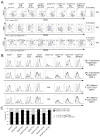VprBP Is Required for Efficient Editing and Selection of Igκ+ B Cells, but Is Dispensable for Igλ+ and Marginal Zone B Cell Maturation and Selection
- PMID: 26150531
- PMCID: PMC4530030
- DOI: 10.4049/jimmunol.1500952
VprBP Is Required for Efficient Editing and Selection of Igκ+ B Cells, but Is Dispensable for Igλ+ and Marginal Zone B Cell Maturation and Selection
Abstract
B cell development past the pro-B cell stage in mice requires the Cul4-Roc1-DDB1 E3 ubiquitin ligase substrate recognition subunit VprBP. Enforced Bcl2 expression overcomes defects in distal VH-DJH and secondary Vκ-Jκ rearrangement associated with VprBP insufficiency in B cells and substantially rescues maturation of marginal zone and Igλ(+) B cells, but not Igκ(+) B cells. In this background, expression of a site-directed Igκ L chain transgene increases Igκ(+) B cell frequency, suggesting VprBP does not regulate L chain expression from a productively rearranged Igk allele. In site-directed anti-dsDNA H chain transgenic mice, loss of VprBP function in B cells impairs selection of Igκ editor L chains typically arising through secondary Igk rearrangement, but not selection of Igλ editor L chains. Both H and L chain site-directed transgenic mice show increased B cell anergy when VprBP is inactivated in B cells. Taken together, these data argue that VprBP is required for the efficient receptor editing and selection of Igκ(+) B cells, but is largely dispensable for Igλ(+) B cell development and selection, and that VprBP is necessary to rescue autoreactive B cells from anergy induction.
Copyright © 2015 by The American Association of Immunologists, Inc.
Figures










Similar articles
-
B cell deletion, anergy, and receptor editing in "knock in" mice targeted with a germline-encoded or somatically mutated anti-DNA heavy chain.J Immunol. 1998 Nov 1;161(9):4634-45. J Immunol. 1998. PMID: 9794392
-
Transcription factor NF-kappa B regulates Ig lambda light chain gene rearrangement.J Immunol. 2001 Jul 1;167(1):264-9. doi: 10.4049/jimmunol.167.1.264. J Immunol. 2001. PMID: 11418658
-
E2A and IRF-4/Pip promote chromatin modification and transcription of the immunoglobulin kappa locus in pre-B cells.Mol Cell Biol. 2006 Feb;26(3):810-21. doi: 10.1128/MCB.26.3.810-821.2006. Mol Cell Biol. 2006. PMID: 16428437 Free PMC article.
-
Dynamic Control of Long-Range Genomic Interactions at the Immunoglobulin κ Light-Chain Locus.Adv Immunol. 2015;128:183-271. doi: 10.1016/bs.ai.2015.07.004. Epub 2015 Aug 14. Adv Immunol. 2015. PMID: 26477368 Review.
-
Transcription factories in Igκ allelic choice and diversity.Adv Immunol. 2019;141:33-49. doi: 10.1016/bs.ai.2018.11.001. Epub 2018 Dec 19. Adv Immunol. 2019. PMID: 30904132 Free PMC article. Review.
Cited by
-
Receptor editing constrains development of phosphatidyl choline-specific B cells in VH12-transgenic mice.Cell Rep. 2022 Jun 14;39(11):110899. doi: 10.1016/j.celrep.2022.110899. Cell Rep. 2022. PMID: 35705027 Free PMC article.
-
The CRL4VPRBP(DCAF1) E3 ubiquitin ligase directs constitutive RAG1 degradation in a non-lymphoid cell line.PLoS One. 2021 Oct 14;16(10):e0258683. doi: 10.1371/journal.pone.0258683. eCollection 2021. PLoS One. 2021. PMID: 34648572 Free PMC article.
-
VprBP (DCAF1) Regulates RAG1 Expression Independently of Dicer by Mediating RAG1 Degradation.J Immunol. 2018 Aug 1;201(3):930-939. doi: 10.4049/jimmunol.1800054. Epub 2018 Jun 20. J Immunol. 2018. PMID: 29925675 Free PMC article.
-
RACK1 is required for normal B cell development and signaling but not RAG1 degradation.J Immunol. 2025 Aug 24:vkaf217. doi: 10.1093/jimmun/vkaf217. Online ahead of print. J Immunol. 2025. PMID: 40849887
-
DCAF1 (VprBP): emerging physiological roles for a unique dual-service E3 ubiquitin ligase substrate receptor.J Mol Cell Biol. 2019 Sep 19;11(9):725-735. doi: 10.1093/jmcb/mjy085. J Mol Cell Biol. 2019. PMID: 30590706 Free PMC article.
References
-
- Schatz DG, Swanson PC. V(D)J Recombination: Mechanisms of Initiation. Annual Review Genetics. 2011;45:167–202. - PubMed
-
- Sitte S, Glasner J, Jellusova J, Weisel F, Panattoni M, Pardi R, Gessner A. JAB1 is essential for B cell development and germinal center formation and inversely regulates Fas ligand and Bcl6 expression. J Immunol. 2012;188:2677–2686. - PubMed
Publication types
MeSH terms
Substances
Grants and funding
LinkOut - more resources
Full Text Sources
Other Literature Sources
Molecular Biology Databases
Miscellaneous

